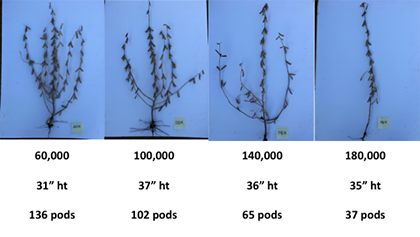May 30, 2018

Source: South Dakota State University
By Jonathan Kleinjan, Adam Varenhorst, and Brady Hauswedell
There have been reports in recent years that agronomists in states such as Iowa, Nebraska and Wisconsin have observed success when reducing soybean planting populations. In some cases, seeding rates have been reduced from the normal recommended rate of 140,000 seeds/acre down to rates as low as 105,000. Reducing plant population can have benefits such as reducing the incidence of white mold (which has been an increasing concern in eastern South Dakota) and lowering seed cost. If a unit of soybean seed is $60, every 1,000 seeds/acre reduction in seeding rate will save about $.43. For example, if seeding rates are reduced by 20,000 seeds/acre, the savings would be 20,000 seeds/acre x $.43/1000 seeds = $8.60 per acre.
In 2016 and 2017, SDSU researchers examined seven planting populations ranging from 60,000 to 180,000 seeds/acre on two planting dates (early May and early June) at four locations in eastern South Dakota. All plots were planted using conventional tillage in 30-inch rows. Yield levels tended to be higher for the early May planting versus the early June planting, although this relationship depended on the timing of precipitation events. Many university researchers recommend to increase planting rates at later seeding dates to compensate for less vegetative growth and a reduced grain fill period. However, in this study, the most economically viable planting population for soybeans was found to be 140,000 seeds/acre for both the early and late planting dates. Yield results for each of the seven planting populations averaged over two planting dates are shown in Figure 1.

Figure 1. Yield levels for seven soybean planting populations in eastern South Dakota.
It is important to note that yield levels are fairly flat across seeding rates. In the 2016 early May planted trial, the 60,000 seeds/acre planting population was actually the highest yielding when averaged across locations. How is this possible? Soybeans have a remarkable ability to compensate for low planting populations by increasing branches, nodes, and ultimately, pods. The difference in plant structure across four seeding rates is shown in Figure 2. Purdue research suggests that a final stand of 80,000 plants per acre (in 30 inch rows) is adequate for achieving 100% of yield potential.

Figure 2. Soybean plants from 60k through 180k seeding rates. Plant height and number of pods varied by seeding rates. Courtesy: Jonathan Kleinjan
South Dakota research points to an ideal soybean planting population of 140,000 seeds/acre. Individual producers may want to increase the seeding rate slightly for narrow row spacing, in heavy residue conditions, or as planting dates get later.
For Further Information:
•Conley, S.P., J.M. Gaska, S. Mourtiznis, D. Mueller, and A. Varenhorst. 2018. Adjust Your Seeding Rate but not Your Maturity Group for Late May Planted Soybean. Cool Bean. University of Wisconsin Extension. Madison, WI.
•Pedersen, P. 2005. Production Costs: Seeding Rates May Be a Place to Save. Iowa State University Extension. Ames, IA.
•Recommended Soybean Planting Populations. 2010. CropWatch. Nebraska Extension. Lincoln, NE.
Originally posted by South Dakota State University.
You May Also Like




